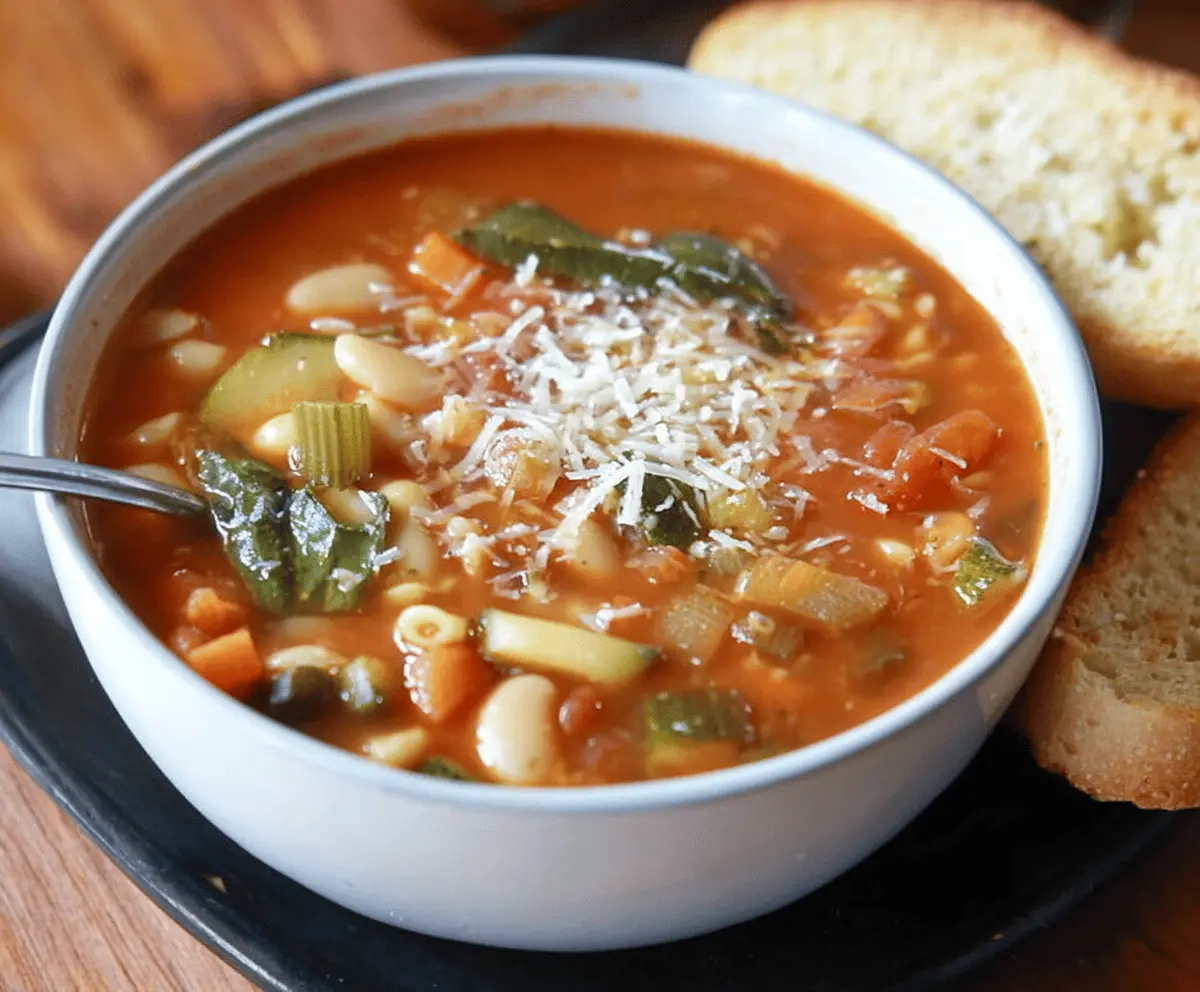Classic Minestrone Soup is a comforting mix of hearty vegetables, beans, pasta, and a rich tomato broth. It’s a colorful bowl full of flavors and textures, from tender carrots and zucchini to savory beans and tiny pasta shapes that soak up all the goodness. This soup feels like a warm hug on a chilly day.
I love making minestrone because it’s so flexible—you can toss in whatever veggies you have on hand or swap out the pasta for rice or quinoa. It’s one of those recipes where a little patience lets all the flavors meld together perfectly, and the smell as it simmers fills the kitchen with something wonderful. Plus, it’s a great way to sneak in a bunch of healthy ingredients.
To me, minestrone tastes best served with a sprinkle of Parmesan cheese and a slice of crusty bread for dipping. I like to make a big pot so there’s plenty for leftovers—it actually tastes even better the next day! It’s a simple, classic soup that brings people together and feels like home with every spoonful.
Key Ingredients & Substitutions
Olive oil: This is the base for sautéing and adds a light, fruity flavor. If you don’t have olive oil, vegetable or canola oil works fine.
Onion, garlic, carrots, and celery: The classic soup veggies that build flavor. Feel free to add or swap with leeks or bell peppers for a twist.
Zucchini and green beans: Fresh veggies bring texture and color, but frozen peas or spinach are great options if fresh isn’t available.
Beans: Kidney and cannellini beans add creaminess and protein. You can substitute with chickpeas or black beans depending on what you like or have.
Vegetable broth: The flavorful liquid base. Homemade is best, but good-quality store-bought broth works well too. For a non-vegetarian twist, you can use chicken broth.
Small pasta: Elbow macaroni or ditalini are perfect as they hold up well in soup. Or try small shells or orzo. For gluten-free, use quinoa or rice instead.
Herbs and seasoning: Dried oregano, basil, and thyme add classic Italian flavor. Fresh herbs will taste even brighter if you have them on hand.
Parmesan cheese: Adds a salty finish and richness to the soup. Use vegan cheese if you want a dairy-free option.
How Do I Get the Best Flavor and Texture from My Vegetables?
Cooking the vegetables properly is key to rich flavor and a great texture. Here’s how I do it:
- Sauté aromatics first: Cook onion, garlic, carrots, and celery slowly in olive oil until softened (about 5-7 minutes). This builds a flavor base.
- Add firmer veggies next: Toss in zucchini and green beans, cooking for a few more minutes to keep them slightly crisp and fresh in the final soup.
- Simmer with broth and beans: Let the soup bubble gently for 20 minutes so all the flavors blend together well.
- Add pasta last: Stir in small pasta at the end and cook until tender but not mushy, usually about 8-10 minutes. This keeps the pasta from getting soggy.
Patience while simmering gives you that comforting, balanced taste you want. Remember to adjust salt and pepper at the end to suit your preference!

Equipment You’ll Need
- Large soup pot – I like it because it gives plenty of room for all the ingredients and keeps everything simmering evenly.
- Vegetable peeler (optional) – handy if you want to peel zucchini or carrots for a smoother texture.
- Cutting board and sharp knife – for chopping vegetables quickly and safely.
- Wooden spoon or ladle – perfect for stirring the soup and serving without scratching your pot.
- Measuring spoons and cups – to keep the seasoning just right.
- Small pot for cooking pasta – or cook pasta separately and add when serving to keep it from getting mushy.
Flavor Variations & Add-Ins
- Swap beans: Use chickpeas or black beans for a different flavor and texture.
- Extra veggies: Add spinach, kale, or zucchini noodles for more greens and freshness.
- Protein boost: Stir in cooked sausage, shredded chicken, or crumbled bacon for added heartiness.
- Spice it up: Add red pepper flakes or a dash of hot sauce if you like a little heat.

How to Make Classic Minestrone Soup
Ingredients You’ll Need:
- 2 tablespoons olive oil
- 1 medium onion, diced
- 2 cloves garlic, minced
- 2 medium carrots, diced
- 2 celery stalks, diced
- 1 medium zucchini, diced
- 1 cup green beans, cut into 1-inch pieces
- 1 (14-ounce) can diced tomatoes
- 1 (15-ounce) can kidney beans, drained and rinsed
- 1 (15-ounce) can cannellini beans, drained and rinsed
- 6 cups vegetable broth
- 1 teaspoon dried oregano
- 1 teaspoon dried basil
- ½ teaspoon dried thyme
- Salt and black pepper to taste
- ¾ cup small pasta (like elbow macaroni or ditalini)
- Fresh thyme or parsley for garnish
- Freshly grated Parmesan cheese for serving
Time Needed
This recipe takes about 10 minutes to prep, 30 minutes to cook, so around 40 minutes total. Most of that time is just letting the soup simmer to develop its delicious flavors.
Step-by-Step Instructions:
1. Sauté the Veggies
Heat the olive oil in a large pot over medium heat. Add the diced onion, garlic, carrots, and celery. Cook, stirring occasionally, until the vegetables are soft and fragrant — about 5 to 7 minutes.
2. Add Zucchini and Green Beans
Throw in the diced zucchini and green beans. Cook another 3 to 4 minutes, stirring from time to time, so the veggies stay just tender.
3. Add Tomatoes and Beans
Stir in the diced tomatoes with their juices. Then add the kidney beans and cannellini beans. Give everything a good stir.
4. Pour in Broth & Herbs
Pour in the vegetable broth, then sprinkle in oregano, basil, thyme, salt, and pepper. Bring the soup to a boil, then reduce the heat to low and let it simmer gently for about 20 minutes. This helps all the flavors come together.
5. Cook the Pasta
Add the small pasta and cook until tender but not mushy, around 8 to 10 minutes. Stir occasionally to keep the pasta from sticking.
6. Taste and Serve
Give the soup a taste and add more salt or pepper if needed. Ladle the soup into bowls, top with a sprinkle of fresh thyme or parsley, and finish with a good amount of grated Parmesan cheese. Serve warm with crusty bread for dipping—enjoy!

Can I Use Frozen Vegetables for Minestrone Soup?
Yes, you can! Just add frozen veggies a little earlier in the cooking process to make sure they fully thaw and cook through. Adjust cooking time as needed since frozen veggies release extra moisture.
How Can I Make Minestrone Soup Gluten-Free?
Simply swap the small pasta for gluten-free pasta, rice, or quinoa. Add these towards the end of cooking and monitor closely so they don’t overcook.
Can I Prepare Minestrone Soup Ahead of Time?
Absolutely! The flavors actually develop more after sitting overnight. Store in an airtight container in the fridge for up to 3 days. Reheat gently on the stove before serving.
How Should I Store Leftovers?
Keep leftover soup in a sealed container in the refrigerator for up to 3 days. For longer storage, freeze it in portions for up to 3 months. Thaw overnight in the fridge and reheat on the stove.



